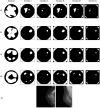Automated breast lesion localisation in microwave imaging employing simplified pulse coupled neural network
- PMID: 35862368
- PMCID: PMC9302781
- DOI: 10.1371/journal.pone.0271377
Automated breast lesion localisation in microwave imaging employing simplified pulse coupled neural network
Abstract
MammoWave is a microwave imaging device for breast lesion detection, employing two antennas which rotate azimuthally (horizontally) around the breast. The antennas operate in the 1-9 GHz band and are set in free space, i.e., pivotally, no matching liquid is required. Microwave images, subsequently obtained through the application of Huygens Principle, are intensity maps, representing the homogeneity of the dielectric properties of the breast tissues under test. In this paper, MammoWave is used to realise tissues dielectric differences and localise lesions by segmenting microwave images adaptively employing pulse coupled neural network (PCNN). Subsequently, a non-parametric thresholding technique is modelled to differentiate between breasts having no radiological finding (NF) or benign (BF) and breasts with malignant finding (MF). Resultant findings verify that automated breast lesion localization with microwave imaging matches the gold standard achieving 81.82% sensitivity in MF detection. The proposed method is tested on microwave images acquired from a feasibility study performed in Foligno Hospital, Italy. This study is based on 61 breasts from 35 patients; performance may vary with larger number of datasets and will be subsequently investigated.
Conflict of interest statement
Lorenzo Sani, Alessandro Vispa and Giovanni Raspa are employed by UBT - Umbria Bioengineering Technologies. Gianluigi Tiberi and Lorenzo Sani are shareholders of UBT - Umbria Bioengineering Technologies. This does not alter our adherence to PLOS ONE policies on sharing data and materials.
Figures








References
-
- Seiffert K, Thoene K, Zu Eulenburg C, Behrens S, Schmalfeldt B, Becher H, et al.. The effect of family history on screening procedures and prognosis in breast cancer patients-Results of a large population-based case-control study. The Breast. 2020. Dec 24. doi: 10.1016/j.breast.2020.12.008 - DOI - PMC - PubMed
Publication types
MeSH terms
LinkOut - more resources
Full Text Sources
Medical
Miscellaneous

